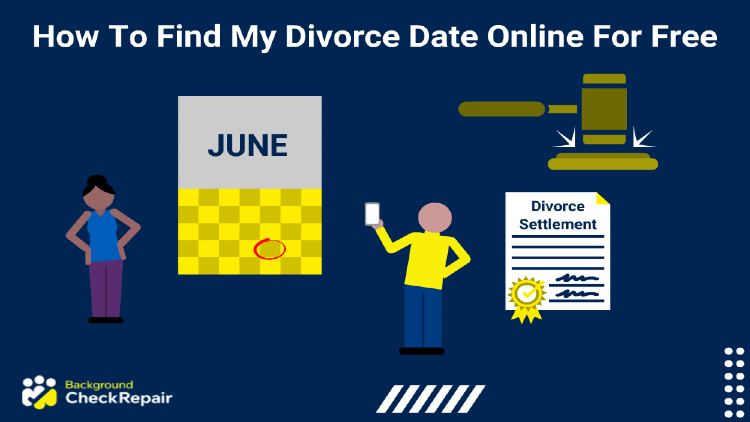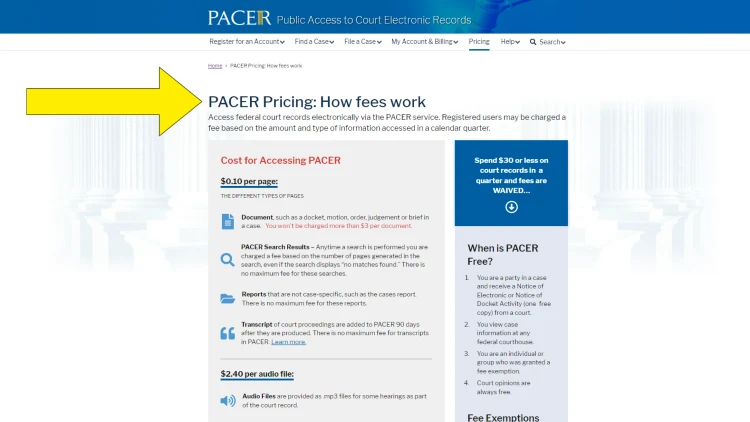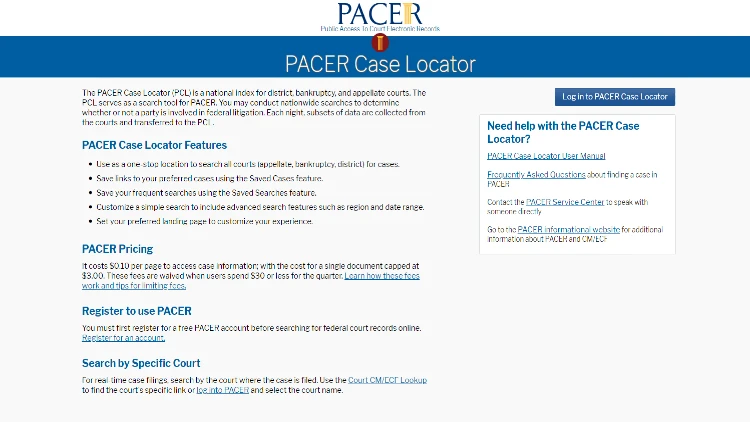How Do I Find My Divorce Records for Free?
For divorce records, the applicant can use the county court’s website, the statewide or federal archives, or the federal PACER system.
 Written by Background Check Repair
Written by Background Check Repair
Background Checks | June 21, 2024

Table of Contents
Need to know how to find my divorce date online for free?
Fortunately, it’s not hard when users understand a very easy court search trick that anyone can access.
Since divorce records are public, the federal government and local court jurisdictions catalog and provide access to these records for anyone to search. The only time these records are not available is if the case itself has been sealed by a court.
Although these documents are usually open to the public, finding them is usually not ‘completely’ free, as most internet search engines demand a fee to see or receive a physical copy of the record. Courts have the authority to levy fees for document searches and copies, but typically these are very low.1
However, there are some methods that can be used to learn how to find my divorce date online for free, if you know where and how to use specific court search tips.
This guide outlines the potentially free options available. But, users may also find divorce dates online by using a weeklong free trial background screening, which will deliver instant results.
There are a variety of reasons why a person might need a copy of a divorce date, including personal usage, genealogy research, and inheritance.
PACER4 is an electronic public access program that allows users to get case and docket information from district courts, bankruptcy, and Federal Appellate courts, as well as via the PACER Case Locator,5 through the website.
Each court keeps track of its own case files in its own database. Because each court maintains its own PACER database system, every jurisdiction has its own Web address. Each judicial program is similar to the others; however, the data format and information may differ significantly.
The US Judiciary provides PACER4 as a service. The Administrative Office of the United States Courts runs the PACER Service Center.
Users who have registered can do the following:
The PACER Service Center can be reached at (800) 676-6856 Monday through Friday between 0800 and 1800, CT, or by email at [email protected].
The cost of accessing case information is $0.10 a page. Billable pages are estimated in two ways, depending on the format. A billable page is calculated for HTML-formatted data using a calculation depending on the number of bytes retrieved (4,320 bytes = 1 billable page).

The number of pages in PDF documents is counted (1 PDF page Equals 1 billable page).
A single document can be accessed for $3.00, which is the same as 30 pages of paperwork and case-specific information such as the claims register, creditor listing, and docket report. Name search results, non-case-specific reports, and copies of federal court hearings are exempt from the cap.
NOTE: If a person’s charges total $30 or less in a quarter, charges are waived for that quarter. In any given quarter, 75% of registered PACER clients do not pay a charge.
The $0.10 per page fee is determined by the number of pages returned by each query and the number of files accessed online for each requested document or report. The fee is not predicated on the fact that the person printed that search or document.
Consider the following examples of how charges are created:
Step 1. Enter “johnson, t” as the party name, and one will get two pages of matches. It will cost them $0.20.
Step 2. Select Docket Report and enter case number 01-10054.
The docket is ten pages long, thus the fee is one dollar. A date range can be entered to cap the number of pages displayed by presenting only the data for the date period instead of all of the report’s items.
Step 3. To read a document, click a link within the docket report. The charge is $0.50 because the document is 5 pages long.
This fee is based on the number of pages returned by any search, including searches that return no results (a fee of $0.10 per page for no results).
Users can register for PACER and follow connections to the courts’ CM/ECF systems6 on the PACER website.
Choose the ‘Register for an Account Overview’ selection below ‘Register for an Account’ to determine the sort of PACER account to use.
If a person is not sure what kind of account they’ll need, they can use the Registration Wizard. This tool will assist them in determining the best registration choice for them. Alternatively, they can select the ‘Case Search Only’ option on the Register for an Account screen.
This PACER selection account allows a person to view, search, and print documents from the district, bankruptcy, and federal appellate courts.
There is no cost to register for the PACER service, but if a person wants to upload court case documents, they must have court approval to register.
The PACER Case Locator5 indexes all federal court filings in appellate, district, and bankruptcy courts across the country. The PACER Case Locator is supplied with freshly collected data every 24 hours, usually at night.

PACER charges ten cents per search for any court case, including divorce records.
Log in to the PACER Case Locator to find a case. If a person is a registered PACER user, they will have access to the PACER Case Locator with their password and login information.
A search will provide the name of the party, the jurisdiction where the matter was filed, the incident number, the date the matter was filed, and the date the case was closed. The incident number in the PACER Case Locator can be used to obtain more extensive case information recorded in CM/ECF.6
Finding your divorce date for free can be done, but it requires a little strategy.
Need to know how to find my divorce date online for free?
A person can look for divorce records on a number of different websites. These websites do all of the legwork, so the person doesn’t have to contact state agencies themselves.
Although searches are usually free, viewing the results requires a charge. The more data a person possesses, the more precise the search results will be.1
So, how to find my divorce date online for free? Here are some of the websites and means one can use to find their divorce dates for free.
The state’s vital records agency can provide a copy of the divorce certificate to anyone. However, they must fill out an application and pay the required cost, as well as provide the requested details.
The Centers for Disease Control and Prevention provides a list of vital records department contacts in every state and territory in the United States.
If the person can go to the court where the divorce was issued, they may be allowed to read the whole divorce record for free, albeit duplicates or certified copies of the divorce certificate would cost money.
If they are unable to attend the courthouse, they may be able to submit a request for records online. Users can search for divorce records online at many courthouses.
Some demand a fee for searches, while others offer free searches and merely charge for hard copies plus any shipping expenses.
Divorce files, similar to marriage records, are accessible to the general public. Anyone can conduct a divorce date search from the home or go to the Department of Health and Vital Records of their state. Although some documents are free, one has to pay for specific private or government services.

To obtain divorce dates, an individual can:
One should learn as much as one can about the other party. Without some fundamental details, finding a divorce record will be tough. At the very least, one should aim to obtain the following:
They should also find out the judicial circuit they filed in. A court circuit is a tribunal’s jurisdiction. Throughout most states, there are fewer court circuits than counties, therefore, one judicial circuit is made up of numerous counties. Just about every government’s justice system has a web page, and a listing of circuits should be included there.
After doing so, they can now carry out their investigation. The person should go to the site’s records center and explore by name. They’ll usually obtain a list of all of that person’s filings. When they look through the files, they’ll get the divorce date.
The identity of the persons who split, the county and state where they separated, and the date of the divorce will be needed by the individual. The individual should then go to the Vital Statistics office7 in the county where the divorce occurred.
They can call the state’s Vital Records Office if they don’t know the county via email, phone, or in person.
After this, the person should submit a records request. They can obtain the documents on the internet. If they don’t have access to a computer, they can come into the office and fill out the request form there. They must normally pay a charge, which is usually less than $20.
Here’s a table showing where to find divorce dates online in all the 50 states.
The person can visit the county’s Vital Statistics office to learn more about the divorce. They can also call the state’s Vital Records Office if they don’t know the county.
Make contact with them via email, phone, or in person. These offices are known by a variety of names.
Although some searches do cost a small amount (under $1), by using local court jurisdictions, anyone can learn how to find my divorce date online for free…it’s just a matter of using a court search trick that anyone can access.
For divorce records, the applicant can use the county court’s website, the statewide or federal archives, or the federal PACER system.
The person can approach the state’s Department of Vital Records in order to obtain a copy of the divorce decree.
Unless a family court has classified the documents, California renders divorce documents available to the public.
For divorce papers, the applicant can use the national or state archives, the county court’s website, or the federal PACER system.
Consult with an attorney, and visit authorized government sites, and third-party sites to get the divorce records.
Use the PACER system.
The Texas Department of State Health Services Vital Statistics Section8 provides free downloads of separation indexes dating back to 1968.
Divorce is governed by Florida’s family law system. Open access to family court documents is possible online and in person at the local county clerk’s office.
Contacting the California County Superior Court where the divorce was granted is the most effective approach to receive a copy of the divorce document.3
1How to Find Divorce Records. (2022, 10 May). WFXG. <https://www.wfxg.com/story/43222742/how-to-find-divorce-records>
2Finding Divorce Records. (2021, 21 August). LoveToKnow. <https://divorce.lovetoknow.com/Free_Divorce_Records>
3How to Obtain a Divorce Decree in California. (2021, 16 November). Fernandez & Karney <https://www.cfli.com/divorce-decree-california/#:%7E:text=The%20most%20efficient%20way%20to,decree%20and%20any%20related%20documents>
4PACER. (2022). What can we help you accomplish? Home. Retrieved June 03, 2022, from <https://pacer.uscourts.gov/>
5PACER. (2022). PACER Case Locator. PACER Case Locator. Retrieved June 03, 2022, from <https://pcl.uscourts.gov/>
6United States Courts. (2022). Electronic Filing (CM/ECF). Court Records. Retrieved June 03, 2022, from <https://www.uscourts.gov/court-records/electronic-filing-cmecf>
7Family Search. (2022). Divorce Records. United States Divorce Records. Retrieved June 03, 2022, from <https://www.familysearch.org/en/wiki/United_States_Divorce_Records>
8Texas Vital Records. (2022). Texas Vital Records. Retrieved June 03, 2022, from <https://www.texas.gov/texas-vital-records/>
We use cookies to ensure that we give you the best experience on our website. If you continue to use this site we will assume that you are happy with it